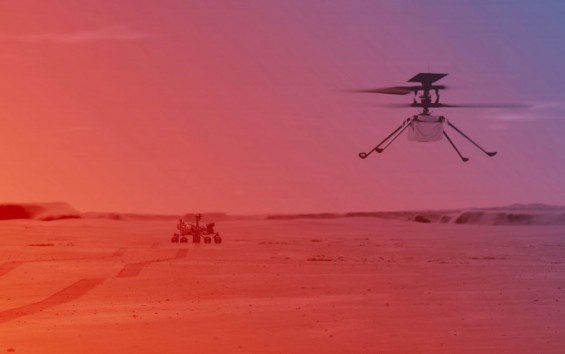
This is the imagination of the Persistence and the small helicopter’Indigenuity’. Provided by NASA
‘Ingenuity’, a small unmanned helicopter on the NASA’s Mars exploration rover’Perciviarance’, which landed on Mars on February 19 (local time) Korean time Settled on the surface of Mars for power flight in celestial bodies. NASA announced on the 4th that Injinyuiti will make its first historic flight on April 11th.
NASA’s Jet Propulsion Research Institute (JPL) said on an official Twitter on the 4th (local time), “Indigenuity was separated from the bottom of Percidence, 10cm from the surface of Mars, and completed a touchdown for power flight.” It is to survive at night.”
Injinnewty weighs 1.8kg, measures 13.6cm in width, 19.5cm in length, and 16.3cm in height, which is the size of a tissue box. Until it was separated from Percivirance, Percivirence’s nuclear system protected it to withstand the harsh Martian nights, which averaged minus 60 degrees Celsius. Currently, Insinuity maintains the system through an internal rechargeable battery. This is to prevent damage to some sensitive electronic devices in cryogenic environments.
Injinnewity is scheduled to make its first flight on April 11th (local time). Flight test data arrives on Earth on the 12th. Two cameras were installed to record the flight, and Persivirance also records the flight of Injinuity. It is the first helicopter to fly on a planet other than Earth, and is designed to test the technology that allows other vehicles to fly on other planets, such as Mars in the future.
The area in which Injinuity first flies is about 60m from the landing site of Percivirence. In order to fly Injin Newity, the landing point must be flat and there must be no large rocks that hinder the flight. It is also necessary to shade the floor to be used by the artificial intelligence (AI)-based navigation camera on Injinity to recognize the position during flight. It was analyzed that the landing site satisfies all of these conditions.
When the flight preparation is done well, Injinyuiti fires the two rotors 2537 times per minute and ascends at a speed of 1m per second. Hovering is carried out to hold it in place for up to 30 seconds within an altitude of 5 m on the surface of Mars. It is expected to land after descending. When the first test is completed, images of Mars’ first flight will be transmitted to Earth. Injinnewity will be on a mission for the largest Mars for 30 days (Earth 31 days). Each flight takes place within an altitude of 5 m and runs in a range of 90 m.
The flight data arrives at Earth one day after Injinyuiti’s flight. The JPL researchers plan to closely analyze the temperature and battery performance to see if the solar cells of Injinuity are working properly, and check the status of Injinuity.
Indigenuity is an example of Mars, assisting Percivirence’s mission to explore the ancient delta in the crater. Percivirence plans to conduct exploration to find traces of ancient creatures over the next two years. After collecting Mars rock samples, the goal is to return the rock samples to Earth through other exploration missions.
